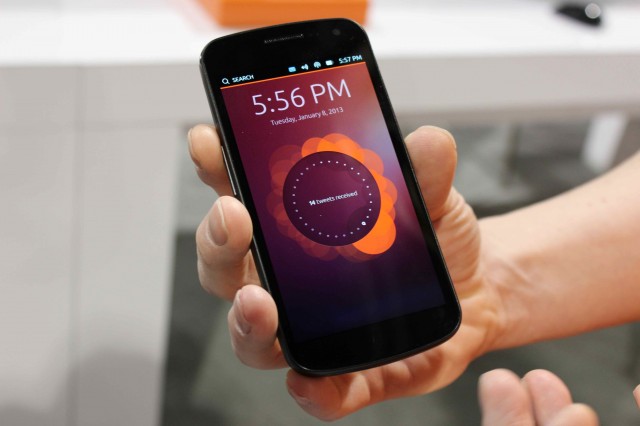
We got to see a smartphone running Ubuntu up close for the first time today. It looks like it works and all, but this article will most definitely not be a "hands-on" report—we weren't allowed to put our hands on it.
Canonical demonstrated a Galaxy Nexus running Ubuntu's phone interface at the Consumer Electronics Show, but product manager Richard Collins explained that the company isn't quite ready to let us use it. "We're just doing all of the driving for the demos for now simply because we understand how the experience works," Collins told me when I asked if I could test it out. In other words: No touching!
I'm confident I could have figured out how to use this contraption—when it comes down to it, most smartphones aren't that different from each other, and this one behaves a lot like Android and the iPhone. But I like the Canonical guys, and I decided it would be impolite to grab the phone and run for the hills.
We do expect to be getting a hands-on experience within a few weeks, because Canonical says it will be releasing a version that can be installed by anyone on a Nexus. Today, Ars reporter Andrew Cunningham and I settled for the controlled demo and an interview, with Andrew taking pictures. Canonical's wireless Internet on the CES expo floor wasn't working, but we could get a sense of the phone's basic functionality.
Ubuntu phones don't use any hardware buttons or "soft" buttons for navigation. The interface presents the standard grid of icons popularized by the iPhone, eschewing something more radical like the Windows Phone live tiles or Android's widgets. Like most phones, Ubuntu can show notifications on the home screen. You can see a Twitter notification in the image at the top of this story, and here is a shot of the main interface:

There are a few differences from other platforms, largely tied to the fact that swiping from any of the four sides of the screen brings up new options. Swiping from the left brings up a Launcher bar from which applications can be opened, nearly identical to the Launcher in the Ubuntu desktop interface. This Launcher can be opened either from the lock screen or from within the phone's standard interface.
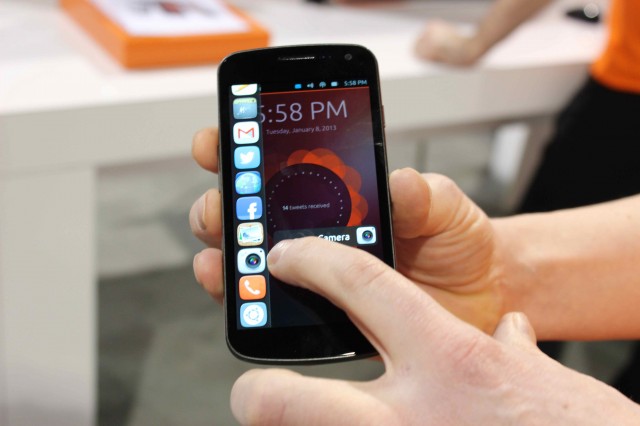
Swiping from the bottom brings up application-specific menus, very much like what you'd see on a Windows 8 or Windows RT tablet. For example, if the app-specific menu is activated from the photo gallery app, you get options to edit and share photos:
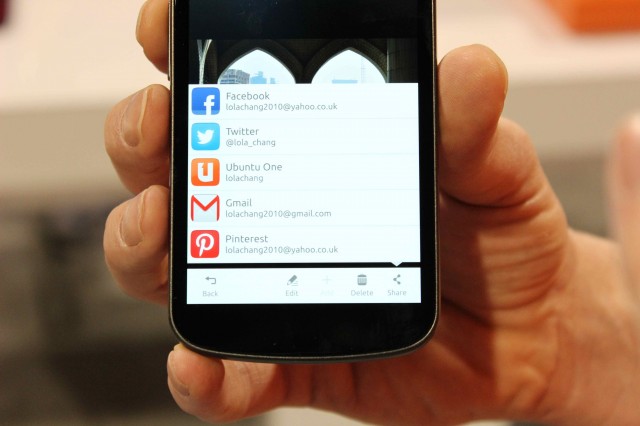
Menus will also allow users to access certain system settings without leaving applications. For example, in the photo app you may want to adjust the brightness without having to navigate to a different part of the operating system.
"On other systems, you have to go from the application to the home screen to the settings menu, make the adjustment, and then go back into the application," Collins said. "This is a very simple, quick way to allow users to adjust settings without making the user navigate away from the application they're using."
Swiping from the right lets you switch from one open application to another, in the same way an iPad user can switch applications with a four-finger swipe. Swiping from the top in Ubuntu reveals a notification area with parts that you can scroll through by moving your finger from right to left, similar to the Ribbon interface in Microsoft Office.
A People application on Ubuntu looks similar to the People application in Windows Phone and Windows 8, with contacts being integrated with social networks such as Facebook:
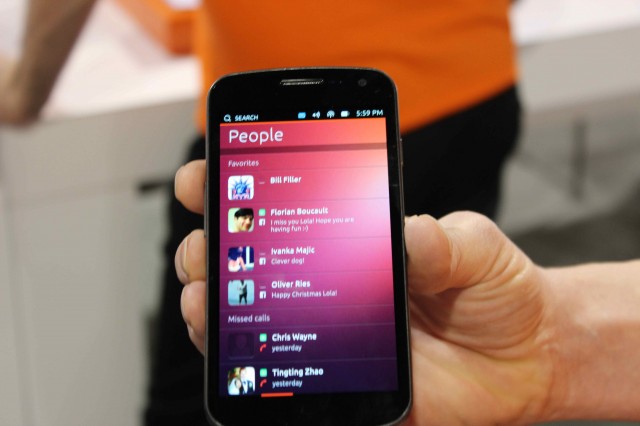

Ubuntu for phones has native applications, but also relies heavily on Web apps that have hooks into the operating system. The browser Ubuntu built for these Web apps use WebKit and the V8 JavaScript engine.
Users will be able to customize what notifications they see on their home screens and what's in their Launcher bar, but the main customization options seem geared toward phone manufacturers. Carriers and hardware makers will be able to put their own applications and services front and center, which doesn't sound appealing but hopefully won't be too obnoxious in practice.
The biggest challenge for Canonical may be convincing carriers and phone makers to sell Ubuntu phones and put some marketing muscle behind them. The company also must still build out the rest of the phone's core experience. It is functional enough today to make phone calls, send text messages, use the camera, and perform other core tasks, Ubuntu community manager Jono Bacon said. Still on the to-do list is a more functional address book, media players, Exchange Active Sync support for mail and calendar, and a better Ubuntu Software Centre (the app store).
You may recall that certain Ubuntu phones will become full Ubuntu PCs when docked with a monitor, mouse, and keyboard. Collins said Canonical is testing this internally and that the software is ready to go, but the company isn't ready to show a docked Ubuntu phone just yet. The Galaxy Nexus doesn't quite meet the hardware requirements to run in docked mode.
"We haven't got the hardware available for public demo just yet, because we've just focused on showing what we want the phone OS to be," Collins said. "It's something that's straightforward for us to enable once we have the hardware."
Canonical was also showing Ubuntu for Android today. Whereas Ubuntu phones will be Ubuntu on both the phone and desktop, Ubuntu for Android turns a standard Android phone into an Ubuntu PC when docked. Using Ubuntu for Android, Collins showed us a telephony application on Ubuntu that can access the Android address book. This is a Samsung Galaxy S3, docked and running Ubuntu on the desktop:
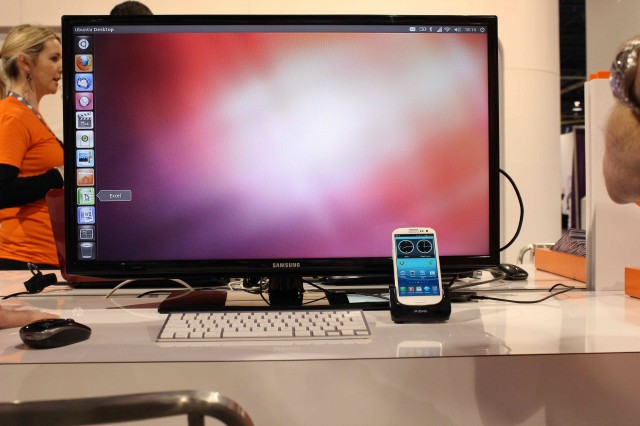
Like the Ubuntu phone OS, the source code for Ubuntu for Android is not yet available. "We don't want users to install it on hardware that we're not sure it can support," Collins said, a statement quite similar to the excuse Google has given for delaying release of Android source code. Canonical officials have said Ubuntu phone development will (eventually) involve the community more than Android's does, however, following a model similar to the Ubuntu desktop code.
Although Canonical is still working on Ubuntu for Android because of Android's dominant market presence, in the long run it hopes to convince users that Ubuntu is the best choice for both phones and desktops.
"Our Ubuntu phone running our Ubuntu desktop is obviously where we want to take our product forward," Collins said.
reader comments
141